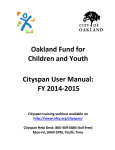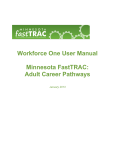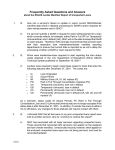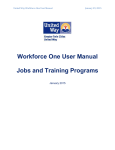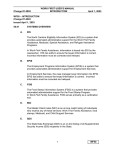Download WORK FIRST USER`S MANUAL Change #1
Transcript
Change #1-2012 WORK FIRST USER’S MANUAL EPIS INSTRUCTIONS DSS-6908 June 1, 2012 EP400 - DSS-6908 Change #1-2012 June 1, 2012 EP400.01 DESCRIPTION OF THE DSS-6908 This form is divided into three major sections as follows: A. Case Data This section contains data pertaining to the participant's Work First Family Assistance eligibility obtained from the Eligibility Information System (EIS) and information concerning the participant's employment and educational status upon entry into Employment Services. B. Program Participation Data This section contains data pertaining to the Work First Employment participant’s participation in program components and other program activities. C. Employment Data This section contains data pertaining to the participant's employment during participation in Work First. EP400.02 GENERAL INSTRUCTIONS An initial Client Participation Record (DSS-6908) is to be keyed for each potential participant who is assessed for participation. DSS-6908 forms should be keyed promptly. The keying deadline for EPIS is the 20th of the month following the month of reported activity. However, if the 20th falls on a weekend or State holiday, the deadline is always the last workday prior to the 20th. When entering information on the DSS-6908, the following guidelines should be followed: A. Use leading zeros, as necessary, to fill spaces in items requiring numeric entries unless otherwise indicated. B. System index numbers are assigned automatically by the computer. A system index number is the file location of particular program participation data or employment data in EPIS. 1 EP400 WORK FIRST USER’S MANUAL EPIS INSTRUCTIONS DSS-6908 Change #5-2006 C. December 1, 2006 The following fields are required to process the DSS-6908: Field 2 (Client EIS Individual ID) Field 3 (Worker ID) EP400.03 1. The county should receive turnaround DSS-6908 forms within three days of data entry. 2. The Client History report is the most reliable verification that the information keyed on a DSS-6908 processed correctly. Client History reports will be automatically generated by the system when an entry is made to program participation data or employment data. 3. No future dates will be accepted by the system. DSS-6908 DATA FIELDS Data fields contained on the DSS-6908 screen are listed below. Data in the fields identified as "EIS fields" cannot be changed in the Employment Programs Information System (EPIS) by keying the DSS-6908. Employment Services staff must contact the Work First Family Assistance case manager if they are aware of a change, and it is not reflected in EIS. A. CASE DATA FIELD 1. COUNTY NUMBER (2 position numeric field) This field contains the number of the county of residence of the client whose EIS Individual ID number appears in Field 2. This is EIS data and cannot be changed through an entry in EPIS. FIELD 2. CLIENT EIS INDIVIDUAL ID (9 position numeric and 1 position alpha entry) This field contains the identification number by which the client is identified in both EIS and EPIS. This is EIS data and cannot be changed through an entry in EPIS. NOTE: When an entry is made in this field, an entry is also required in Field 3 (Worker ID). 2 EP400 Change #5-2006 FIELD 3. WORK FIRST USER’S MANUAL EPIS INSTRUCTIONS DSS-6908 December 1, 2006 WORKER ID (3 position alpha/numeric field) This field must contain at least two characters. A third alpha or numeric character entry may be entered. The entry should contain the initials of the individual to whom the turnaround is to be returned. NOTE: When an entry is made in this field, an entry is also required in Field 2 (Client EIS Individual ID). FIELD 4. UPDATE (6 position numeric field - MM/DD/YY) System generated date that reflects the date the information printed on the DSS-6908 turnaround was processed by the system. FIELD 5. CLIENT HISTORY (1 position alpha field) This field is provided for the county case manager to obtain a profile (Client History report) of the client's participation in Employment Services. The case manager must enter an "X" in this field for the system to generate a Client History report. NOTE: The system will automatically generate a Client History when an entry is made to program participation data or employment data. FIELD 6. TWO PARENT INDICATOR (2 position alpha field) This field represents individuals on two parent cases, i.e.; at least two individuals on case have family status codes of ‘P’. FIELD 7. 6908? (1 position alpha) An identifier used to trigger the printing of the 6908. This field is defaulted to “Y”. Workers not wishing to print current 6908 must change value to “N”. FIELD 8. CLIENT NAME (29 position alpha field) Brought forward from EIS and cannot be changed. This field contains the name of the participant associated with the Client EIS Individual ID. 3 EP400 Change #5-2006 FIELD 9. WORK FIRST USER’S MANUAL EPIS INSTRUCTIONS DSS-6908 December 1, 2006 WORK FIRST FAMILY ASSISTANCE STATUS AND DATE Brought forward from the case status in individual level in EIS and cannot be changed. The system generates the following messages in this field: • • • • • • • • Recipient – (Case status code = R – Recipient) Violt Par – (Case status code = V – Violating Probation or Parole) Nocoop 4D – (Case status code = X – Non-cooperation with IVD) Convict – (Case status code =C – Fleeing Felon) Drugs – (Case status code = D – Drug Related Felony) Residence – (Case status code = H – Misrepresenting Residence) Elig H&I – (Case status code = I – Eligible H&I felon.) Inelig H&I – (Case status code = L – Ineligible H&I felon.) Once terminated, a DSS-6908 is generated by EPIS and the message "Terminated" will appear in this field. The corresponding date is the EIS case termination date, individual termination date, or program transfer effective date. FIELD 10. PROGRAM STATUS AND DATE Brought forward from EIS data and cannot be changed. This field indicates the program status for the individual in Employment Services. The corresponding date is the date the individual's participation status last changed in EIS. FIELD 11. ADDRESS Brought forward from EIS and cannot be changed. This field lists the current address of the participant. FIELD 12. WORK FIRST FAMILY ASSISTANCE PAYMENT AMOUNT AND EFFECTIVE DATE Brought forward from EIS and cannot be changed. This is the monthly Work First Family Assistance payment amount and the effective date of the current payment. 4 EP400 Change #5-2006 FIELD 13. WORK FIRST USER’S MANUAL EPIS INSTRUCTIONS DSS-6908 December 1, 2006 WORK FIRST FAMILY ASSISTANCE CASE ACTION Brought forward from EIS and cannot be changed. This field is used to provide the case manager with system generated messages, including sanction type and begin and end dates. FIELD 14. CLIENT SOCIAL SECURITY NUMBER (9 position numeric field) Brought forward from EIS and cannot be changed. This is the social security number currently being used by the participant. FIELD 15. RACE (1 digit alpha field) Brought forward from EIS and cannot be changed. This is the race of the participant. FIELD 16. SEX (1 position alpha field) Brought forward from EIS and cannot be changed. This is the sex of the participant. FIELD 17. DATE OF BIRTH (6 position numeric field-MM/DD/YY) Brought forward from EIS and cannot be changed. This is the date of birth of the participant. FIELD 18. COUNTY CASE NUMBER (5 position alpha/numeric field) Brought forward from EIS and cannot be changed. This is the number assigned by the county to an individual's case record. FIELD 19. DISTRICT (3 position numeric field) Brought forward from EIS and cannot be changed. This is the number assigned by a county to determine the location of a case record within an agency. FIELD 20. EIS CASE ID (8 position numeric field) Brought forward from EIS and cannot be changed. This is a system assigned number by which an individual's case record is retained in the EIS. 5 EP400 Change #2-2009 FIELD 21. WORK FIRST USER’S MANUAL EPIS INSTRUCTIONS DSS-6908 October 1, 2009 TRACKING INDICATOR A ‘Y’ IN THIS FIELD DOES NOT INDICATE THE INDIVIDUAL IS IN 24-MONTH TRACKING IN EIS. TO VERIFY TRACKING, CHECK THE ELIGIBILITY TRACKING SCREEN (ET) IN EIS. This field is required when activating a case in EPIS. Valid entries are ‘N’ and ‘Y’. However, a ‘Y’ should always be keyed in this field. Once a ‘Y’ is keyed, the system displays the current date beside the ‘Y’. The entry in this field does not affect 24-month tracking in EIS. The 24-month tracking process begins with EPIS sending a nightly file to EIS of all individuals in ‘Active’ status in EPIS. The tracking indicator field is not used for this purpose. EIS processes this nightly file to determine which individuals must have 24-month tracking started. Below are the EIS criteria the individual must meet in order to start 24-month tracking. The individual must: • • • • FIELD 22. Have a valid work registration code in EIS of A, B, C, L, Q, W, or Z, and; Have a payment type in EIS of 1 or 2, and; Not have an individual termination date in EIS, and; If payment type = 2 a check must be displayed in check history for current month. ASSESSMENT DATE (6 position numeric field-MM/DD/YY) This field is protected and allows no data entry. The Client Participant screen displays prior dates for existing individuals and ‘000000’ (zeroes) for new individuals. FIELD 23. EDUCATIONAL STATUS (1 position alpha field) This field is protected and allows no data entry. The Client Participant screen displays prior data for existing individuals and is blank for new individuals. FIELD 24. WORK HISTORY STATUS (1 position alpha field) This field is protected and allows no data entry. The Client Participant screen displays prior data for existing individuals and is blank for new individuals. 6 EP400 Change #2-2009 FIELD 25. WORK FIRST USER’S MANUAL EPIS INSTRUCTIONS DSS-6908 October 1, 2009 EMPLOYMENT STATUS (1 position alpha field) This field is protected and allows no data entry. The Client Participant screen displays prior data for existing individuals and is blank for new individuals. FIELD 26. EDUCATION LEVEL (2 position numeric field) This is the last completed grade level of the participant. This field must be completed at the Initial Employment Services Assessment and must be updated as the participant's education level is upgraded. NOTE: When an entry is made in this field, an entry is also required in Field 27 (Date Attained). FIELD 27. DATE ATTAINED (4 position numeric field - MM/YY) This is the date the current education level was attained by the participant. This cannot be a future date. NOTE: When an entry is made in this field, an entry is also required in Field 26 (Education Level). FIELD 28. LITERACY LEVEL (3 position numeric field) (Optional) This field tracks the literacy development of the participant. Enter only the Reading score, not a combined Reading and Math scores. Each CASAS Reading score of the participant should be entered in this field as it is collected. Scores should be reported in the following sequence: Life Skills Appraisal reading score, first pre-test reading score, first post-test reading score, second pre-test reading score, second post-test reading score and so forth, as appropriate. NOTE: The valid range of CASAS Reading scores is 000 and 150-260. EPIS will not accept scores that do not fall within this range. NOTE: When an entry is made in this field, an entry is also required in Field 29 (Date Attained). FIELD 29. DATE ATTAINED (4 position numeric field-MM/YY) (Optional) If Field 28 is complete, this is the date the reported literacy level is determined. 7 EP400 Change #2-2009 B. WORK FIRST USER’S MANUAL EPIS INSTRUCTIONS DSS-6908 October 1, 2009 PROGRAM PARTICIPATION DATA FIELD 30. INDEX NUMBER (2 position numeric field automatically assigned by EPIS) This is a system assigned locator for the Component Administrative Action Code entered in Field 31. FIELD 31. COMPONENT/ADMINISTRATIVE ACTION (2 position alpha field) This is the component or administrative action in which an individual is a participant. NOTE: When an entry is made in this field, an entry is also required in Field 32 (Activity/Type Code). Fields 31/32 must be valid combinations. Do not enter duplicate combinations for Fields 31 and 32, as the system will reject the form. FIELD 32. ACTIVITY/TYPE (2 position numeric field) This is the type of program activity or type of training for a participant. NOTE: When an entry is made in this field, an entry is also required in Field 31 (Component/ Administrative Action). Field 31/32 must be valid combinations. FIELD 33. PROVIDER CODE (2 position numeric field) This is the primary provider of component activities. "Provider" means the agency that actually performs the component activity (i.e., instruction or training). NOTE: An entry is required in this field when entries are made in Field 31 (Component/Administrative Action), and Field 32 (Activity/Type). FIELD 34. BEGINNING DATE (6 position numeric field-MM/DD/YY) This is the beginning date of the Activity/Type entered in Field 32. The date entered must be greater than or the same as the Assessment Date (Field 22) and not greater than the current calendar date. 8 EP400 Change #2-2009 WORK FIRST USER’S MANUAL EPIS INSTRUCTIONS DSS-6908 October 1, 2009 If the participant is currently in good cause status (DE), the good cause action must be closed at least one day prior to opening an active component/action. If the participant is currently in an open component, the component must be closed at least one day prior to placing the participant in good cause statues. If a participant is placed in ‘DE’ and in 24 month tracking, the 24-month time limit continues. EXAMPLE: The active component closed on October 31, 1999, and the DE component opened on November 1, 1999. Key the data to close all open components. Reenter the EIS ID number and key the DE component. FIELD 35. ENDING DATE (6 position numeric field - MM/DD/YY) This is the ending date of a component. This date must be greater than the date entered in Field 34 (Beginning Date). NOTE: When an entry is made in this field, an entry is required in Field 36 (Ending Reason). FIELD 36. ENDING REASON (1 position numeric field) This is the status of the individual's participation as of the reported ending date. NOTE: An entry is required in this field when an entry is made in Field 35 (Ending Date). FIELD 37. SELF-INITIATED (1 position alpha field) This field must contain an entry. This identifies participant self-initiated activity in Post Secondary Education (PS). The valid entries are: "Y" Enter code ‘Y’ when the Component/ Administrative Action Code entered in Field 31 is ‘PS’ and ‘ST’ the activity meets the definition of Self-Initiated Education or Training contained in the Work First Manual. "N" Enter ‘N’ when the above conditions do not exist. 9 EP400 Change #1-2012 WORK FIRST USER’S MANUAL EPIS INSTRUCTIONS DSS-6908 June 1, 2012 NOTE: When an entry is made in Field 31 (Component/ Administrative Action), an entry is also required in this field. FIELD 38. MONTHLY REPORT DATE (4 position numeric field - YYMM) This is the month and year for which program participation data is being reported. NOTE: When an entry other than ‘DE’, ‘PR’, or ‘JF’ is made in Field 31 (Component/ Administrative Action), an entry is required in this field. FIELD 39. NUMBER OF HOURS SCHEDULED (3 position numeric field) This is the total monthly number of hours an individual is scheduled to participate in a component/activity. If participation is reported in minutes, convert to hours at the end of the month. After converting the minutes for the month, round any excess minutes. If 1-29 minutes, round down to the nearest hour. If 30-59 minutes, round up to the nearest hour. The number of hours scheduled must be greater than or equal to the number of hours completed. NOTE: When an entry other than ‘DE’, ‘PR’, or ‘JF’ is made in Field 31 (Component/ Administrative Action), an entry is required in this field. FIELD 40. NUMBER OF HOURS COMPLETED (3 position numeric field) If participation is reported in minutes, convert to hours at the end of the month. Convert using the procedures above. The number of hours completed may be less than, greater than, or equal to the number of hours scheduled. This is the total monthly number of hours an individual actually participates in the component/activity during the report month. NOTE: When an entry other than ‘DE’, ‘PR’, or ‘JF’ is made in Field 31 (Component/ Administrative Action), an entry is required in this field. 10 EP400 Change #2-2009 WORK FIRST USER’S MANUAL EPIS INSTRUCTIONS DSS-6908 October 1, 2009 FIELD 40A. EXCUSED ABSENCE HOURS (3 position numeric field) Excused Absence Hours may be entered with Work Experience (AW), Job Search (JS), Community Service (CS), Vocational Education Training (VT), Skills Training (ST), and Education (ED) components. Up to 16 hours per month and no more than 80 hours (10 days) in a 12 month period is allowed. No more than 16 hours (2 days) is allowed in any month. FIELD 40B. HOLIDAY HOURS (3 position numeric field) Holiday Hours may be entered with Work Experience (AW), Job Search (JS), Community Service (CS), Vocational Education Training (VT), Skills Training (ST), and Education (ED) components. Up to 80 hours (10 days) in a 12 month period is allowed. FIELD 41. NUMBER OF WEEKS (2 position numeric field) This two position numeric field represents the number of weeks during which an individual actually completes at least one hour of activity in a component. The number of weeks must be converted to a monthly amount. This is determined by the average weekly hours multiplied by 4.3636, except for the month of February. February is considered to have exactly four weeks. See the conversion chart in section 118 of the Work First Manual. The first number indicates the actual number of weeks. Valid entries are 1, 2, 3, 4, or 5. The second number is used to identify whether the completed hours are counted toward the participation rate calculation. Valid entries are ‘0’, ’6’, or ‘9’. A ‘0’ in the second digit field means the participant is making satisfactory progress in the component. A ‘6’ in the second digit field can only be used with the Job Search (JS) component. These hours are counted in the participation rate calculation. NOTE: JS countable hours are limited to 12 weeks in a federal fiscal year. 11 EP400 Change #2-2009 WORK FIRST USER’S MANUAL EPIS INSTRUCTIONS DSS-6908 October 1, 2009 A ‘9’ in the second digit field means the participant is not making satisfactory progress in the component. A ‘9’ is only valid for countable activities. (These hours are NOT included in the participation rate calculation.) WHEN COMPLETED HOURS ARE ENTERED AS ZERO, WEEKS MUST BE ENTERED AS ZERO. NOTE: When an entry is made in this field, an entry is also required in Field 40 (Number of Hours Completed). An entry must be made in Field 41 before the participant will be included in the calculation. C. EMPLOYMENT DATA FIELD 42. INDEX NUMBER (2 position numeric field) This is a system assigned locator for a particular job type entered in Field 43. FIELD 43. JOB TYPE (2 position numeric field) This is the type of employment the participant entered. NOTE: When an entry is made in this field, an entry is also required in Field 44 (Beginning Date), Field 46 (Job Development and Placement/Employment Type), Field 47 (Date), and Field 48 (Number of Hours Scheduled). FIELD 44. BEGINNING DATE (6 position numeric field-MM/DD/YY) This is the beginning date of entered employment. This date must not be greater than the current calendar date. NOTE: When an entry is made in this field, an entry is also required in Field 43 (Job Type). FIELD 45. ENDING DATE (6 position numeric field-MM/DD/YY) This is the ending date of the entered employment. This date must be greater than the date entered in Field 44 (Beginning Date), or prior to or the same as the current calendar date. FIELD 46. JOB DEVELOPMENT AND PLACEMENT/EMPLOYMENT TYPE (2 position alpha field.) 12 EP400 Change #1-2012 WORK FIRST USER’S MANUAL EPIS INSTRUCTIONS DSS-6908 a. June 1, 2012 Job Development and Placement: This identifies whether the employment obtained was a result of Job Development and Placement activity or participation in any component activity. The valid entries for the field are: "Y" Yes "N" No. Must have an open component of ‘AE’, ‘ED’, ‘JS’, ‘OJ’, ‘ST’, or ‘AW’ for the same month and year entered in Field 38 or one month prior to the date entered in Field 47. NOTE: When an entry is made in this field, an entry is also required in Field 43 (Job Type). b. Employment Type: Identifies whether the employment is subsidized, unsubsidized or private sector. The valid entries for the field are: FIELD 47. A Subsidized Private Sector Employment B Subsidized Public Sector Employment U Unsubsidized Employment MONTHLY REPORT DATE (4 position numeric field-YYMM) This is the month and year for which employment obtained after participation is reported. NOTE: When an entry is made in this field, an entry is also required in Field 49 (Number of Hours Worked), Field 50 (Number of Weeks), and Field 51 (Wage Range). FIELD 48. NUMBER OF HOURS SCHEDULED (3 position numeric field) This is the total monthly number of hours the participant is scheduled to work during the report month. If participation is reported in minutes, convert to hours at the end of the month. After converting the minutes for the month, round any excess minutes. 13 EP400 Change #2-2009 WORK FIRST USER’S MANUAL EPIS INSTRUCTIONS DSS-6908 October 1, 2009 If 1-29 minutes, round down to the nearest hour. If 30-59 minutes, round up to the nearest hour. The number of hours scheduled must be greater than or equal to the number of hours completed. NOTE: When an entry is made in this field, an entry is also required in Field 43 (Job Type). FIELD 49. NUMBER OF HOURS WORKED (3 position numeric field) This is the total monthly number of hours an individual actually works during the report month. If participation is reported in minutes, convert to hours at the end of the month. Convert using the procedures above. The number of hours completed may be less than, greater than, or equal to the number of hours scheduled. NOTE: When an entry is made in this field, an entry is also required in Field 50 (Number of Weeks). FIELD 50. NUMBER OF WEEKS (2 position numeric field) This two position numeric field represents the number of weeks during which an individual actually completes at least one hour of activity in employment. The number of weeks in a month is to be calculated based on the number of Mondays in the month. Refer to the Work First Manual, section 118, for the number of weeks in each month. Weeks should be entered as 1=1.0, 2=2.0, 3=3.0, 4=4.0, and 5=5.0. NOTE: When an entry is made in this field, an entry is also required in Field 49 (Number of Hours Worked). WHEN COMPLETED HOURS ARE ENTERED AS ZERO, WEEKS MUST BE ENTERED AS ZERO. FIELD 51. WAGE RANGE (2 position numeric field) This is the entered employment wage range of the participant for employment obtained after participation in Employment Services. NOTE: When an entry is made in this field, an entry is also required in Field 49 (Number of Hours Worked). 14 EP400














